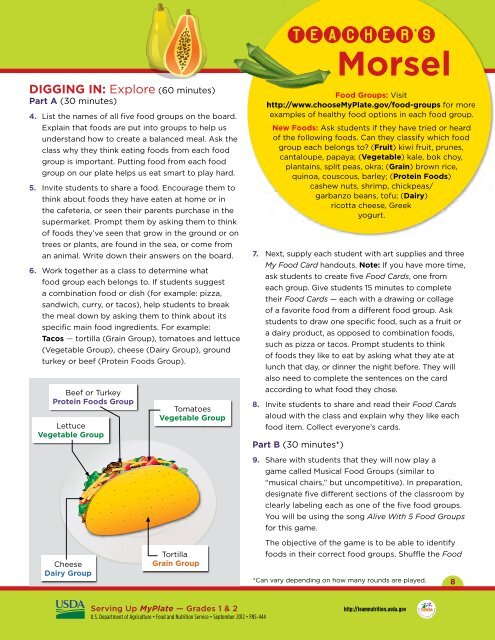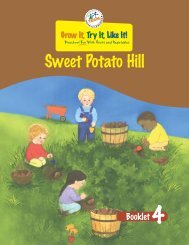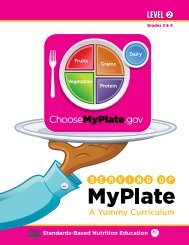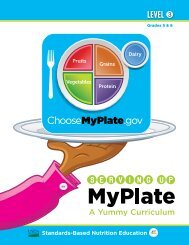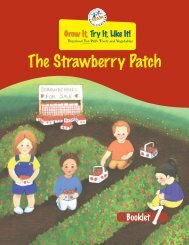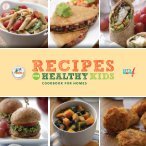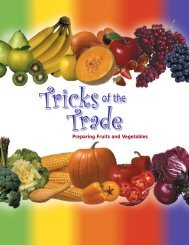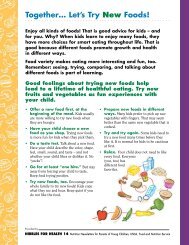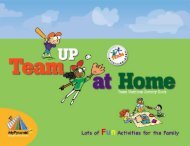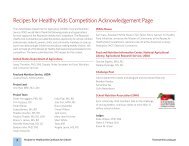Serving Up MyPlate-A Yummy Curriculum, Level 1 - Team Nutrition ...
Serving Up MyPlate-A Yummy Curriculum, Level 1 - Team Nutrition ...
Serving Up MyPlate-A Yummy Curriculum, Level 1 - Team Nutrition ...
You also want an ePaper? Increase the reach of your titles
YUMPU automatically turns print PDFs into web optimized ePapers that Google loves.
DIGGING IN: Explore (60 minutes)<br />
Part A (30 minutes)<br />
4. List the names of all five food groups on the board.<br />
Explain that foods are put into groups to help us<br />
understand how to create a balanced meal. Ask the<br />
class why they think eating foods from each food<br />
group is important. Putting food from each food<br />
group on our plate helps us eat smart to play hard.<br />
5. Invite students to share a food. Encourage them to<br />
think about foods they have eaten at home or in<br />
the cafeteria, or seen their parents purchase in the<br />
supermarket. Prompt them by asking them to think<br />
of foods they’ve seen that grow in the ground or on<br />
trees or plants, are found in the sea, or come from<br />
an animal. Write down their answers on the board.<br />
6. Work together as a class to determine what<br />
food group each belongs to. If students suggest<br />
a combination food or dish (for example: pizza,<br />
sandwich, curry, or tacos), help students to break<br />
the meal down by asking them to think about its<br />
specific main food ingredients. For example:<br />
Tacos — tortilla (Grain Group), tomatoes and lettuce<br />
(Vegetable Group), cheese (Dairy Group), ground<br />
turkey or beef (Protein Foods Group).<br />
Beef or Turkey<br />
Protein Foods Group<br />
Lettuce<br />
Vegetable Group<br />
Cheese<br />
Dairy Group<br />
Tomatoes<br />
Vegetable Group<br />
Tortilla<br />
Grain Group<br />
TEACHER’S<br />
Morsel<br />
7. Next, supply each student with art supplies and three<br />
My Food Card handouts. Note: If you have more time,<br />
ask students to create five Food Cards, one from<br />
each group. Give students 15 minutes to complete<br />
their Food Cards — each with a drawing or collage<br />
of a favorite food from a different food group. Ask<br />
students to draw one specific food, such as a fruit or<br />
a dairy product, as opposed to combination foods,<br />
such as pizza or tacos. Prompt students to think<br />
of foods they like to eat by asking what they ate at<br />
lunch that day, or dinner the night before. They will<br />
also need to complete the sentences on the card<br />
according to what food they chose.<br />
8. Invite students to share and read their Food Cards<br />
aloud with the class and explain why they like each<br />
food item. Collect everyone’s cards.<br />
Part B (30 minutes*)<br />
9. Share with students that they will now play a<br />
game called Musical Food Groups (similar to<br />
“musical chairs,” but uncompetitive). In preparation,<br />
designate five different sections of the classroom by<br />
clearly labeling each as one of the five food groups.<br />
You will be using the song Alive With 5 Food Groups<br />
for this game.<br />
The objective of the game is to be able to identify<br />
foods in their correct food groups. Shuffle the Food<br />
<strong>Serving</strong> <strong>Up</strong> <strong>MyPlate</strong> — Grades 1 & 2 http://teamnutrition.usda.gov<br />
U.S. Department of Agriculture • Food and <strong>Nutrition</strong> Service • September 2012 • FNS-444<br />
8


